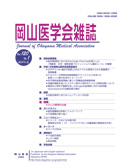

Journal of Okayama Medical Association
Published by Okayama Medical Association<Availability>
Full-text articles are available 3 years after publication.
Permalink : http://escholarship.lib.okayama-u.ac.jp/18699
肝疾患の免疫血清学的研究 第1編 慢性肝疾患におけるL.E.細胞現象,及びその他核貪喰現象出現の臨床的意義に関する検討
間阪 孝文
岡山大学医学部第一内科教室
発行日
1963-12-30
抄録
In the study on the appearance of L. E. cells and other phagocytic phenomena conducted with 54 patients consisting of hepatitis and liver cirrhosis the following results were obtained. 1. Among them four cases proved to be positive to the L. E. cell phenomenon. In the group who did not show the appearance of L. E. cells, those with liver cirrhosis revealed the highest incidence of pseudo-L. E. cell appearance. 2. With the four cases proved to be positive to the L. E. cell phenomenon a series of studies were carried out on their clinical pictures, the results of clinical tests, liver tissue pictures and serological tests and it was found that the Case 1 and 2 belonged to the category of lupoid hepatitis, the Case 3 aside from the L. E. cell phenomenon, did not differ so markedly from general liver cirrhosis, and the Case 4 appeared to be the case of an incomplete type of systemic lupus erythematosus complicated with liver disorders due to blood transfusion but the histological picture of the liver revealed peculiar, active hepatitis showing granuloma formation. 3. In these four cases the manner of L. E. cell appearance and the progress of disease did not parallel with each other. While the relation to the anti-liver antibody remains obscure, three out of the four showed a marked precipitin arc of β(2M)-globulin. 4. A noteworthy fact was that those negative to the L. E. cell phenomenon but with persistent appearance of pseudo-L. E. cells among L. E. cell negative group mostly showed an aggravation and change of serum transaminase. However, relations between the appearance of pseudo-L. E. cells and other nucleophagocytes on one hand and anti-liver antibody and serum gamma globulin on the other could not be verified. 5. Likewise the relation between the appearance of pseudo-L. E. cells and the histological picture of the liver could not be clarified.
ISSN
0030-1558
NCID
AN00032489
